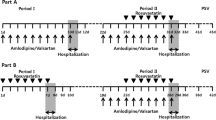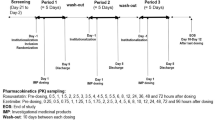Abstract
Twenty two healthy males participated in a randomised, placebo-controlled, double blind, cross-over study to investigate the influence of simvastatin on the pharmacokinetics of ramipril and its active metabolite (ramiprilat), and on the ACE-inhibiting effect of ramiprilat. During two study periods, each of 7 days, subjects received daily either simvastatin 20 mg at 19.00 h or placebo; ramipril (5 mg) was given on Day 5 of each of the periods. Plasma concentrations of ramipril and ramiprilat and ACE-activity were measured in sequential blood specimens, and ramipril and ramiprilat concentrations were measured in urine. Blood and urine collections for pharmacokinetic and pharmacodynamic assessment were made up to 72 h after the dose of ramipril.
The mean AUC of ramipril for ramipril+placebo (R+P) and ramipril+simvastatin (R+S) was 22.2 and 21.3 ng.h.ml−, respectively; for ramiprilat the corresponding figures were 61.3 and 57.6 ng.h.ml−. The urinary excretion of ramipril+metabolites for (R+P) and (R+S) was 25.2 and 24.1% of dose. The maximum percentage inhibition of ACE-activity for (R+P) was 94.6%, and for (R+S) it was 94.1%.
It is concluded that concomitant administration of simvastatin and ramipril has no clinically relevant effect on the pharmacokinetics or ACE-inhibition of the latter drug and its metabolites.
Similar content being viewed by others
References
Dollery C (1991) Ramipril. Therapeutic drugs, (vol 2). Clowes, Beccles London, pp R1-R5
Myron H, Weinberger MD (1985) Antihypertensive therapy and lipids. evidence, mechanisms and implications. Arch Intern Med 145: 1102–1105
Illingworth DR, Bacon S (1987) Hypolipidemic effects of HMG-CoA reductase inhibitors in patients with hypercholesterolemia. Am J Cardiol 60: 33G–42G
Dollery C (1991) Simvastatin. Therapeutic drugs (vol 2). Clowes, Beccles London, pp S25-S29
Shionoiri H (1993) Pharmacokinetic drug interactions with ACE inhibitors. Clin Pharmacokinet 25: 20–58
Eckert HG, Münscher G, Oekonomopulos R, Strecker H, Urbach H, Wissmann H (1985) A radioimmunoassay for the angiotensin converting enzyme inhibitor ramipril and its active metabolite. Arzneimittelforschung/Drug Res 35: 1251–1256
Metzger H, Maier R, Sitter C, Stern HO (1984) 2-(N-((S)-1-ethoxycarbonyl-3-phenylpropyl)-L-alanyl)-(1S, 3S, 5S)-2-azabicyclo (3.3.0)octane-3-carboxylic acid (Hoe 498) — a new and highly effective angiotensin I converting inhibitor. Arzneimittelforschung/Drug Res 34: 1402–1406
Schmidt D, Keller A (1985) Eine empfindliche Methode zur Bestimmung des ACE-Hemmers Ramipril und dessen Metaboliten in Humanurin mittels Capillarsaeulen-Gas-Chromatographie. Fresenius Anal Chem 320: 731–734
Author information
Authors and Affiliations
Rights and permissions
About this article
Cite this article
Meyer, B.H., Scholtz, H.E., Müller, F.O. et al. Lack of interaction between ramipril and simvastatin. Eur J Clin Pharmacol 47, 373–375 (1994). https://doi.org/10.1007/BF00191171
Received:
Accepted:
Issue Date:
DOI: https://doi.org/10.1007/BF00191171




